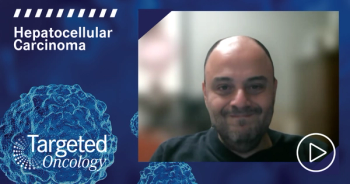
Case 2: A Patient With Solitary HCC <3 cm and a History of Cirrhosis
Moving on to the second case, the panel reviews optimal treatment strategies for a 74-year-old woman with solitary hepatocellular carcinoma <3 cm and a history of cirrhosis
Episodes in this series

Transcript:
Aparna Kalyan, MD: Let’s move on to the next case.
Ben George, MD:Thank you, Dr Kalyan. This is a 74-year-old woman with a 15-year history of cirrhosis. The patient presented with fatigue, increased bleeding, bruising, and swelling around the abdomen. The patient is a recovering alcoholic, a hypertensive, on an ACE inhibitor. She has modestly controlled type 2 diabetes, 10-year duration, and her A1C [glycated hemoglobin] is about 7.5%. Patient is on metformin. She is a retired teacher and volunteers at the library 2 days a week. On ultrasound, multiple nodules were noted, all less than 10 mL. AFP [alpha-fetoprotein] is elevated at 500 ng/mL. A hepatitis panel is negative. Bilirubin of 2.8 mg/dL. She has mild transaminitis and an INR [international normalized ratio] of 1.4. Her renal function is normal, and she has normal blood counts. MRI shows solitary lesion measuring about 2.3 cm, with washout on T2. She’s BCLC [Barcelona Clinic Liver Cancer] A, Child-Pugh B. Good performance status, so ECOG 1.
Aparna Kalyan, MD:What do you think about this case? Do you think this patient could be a candidate for surgery? If you think she’s not a candidate, why do you think she’s not a candidate? Dr Mantry?
Parvez Mantry, MD: Unfortunately, she’s not a candidate for surgery because she’s Child-Pugh B. Anybody with decompensated liver disease is unfortunately not a candidate for surgery. She also has symptoms of hepatic decompensation, which makes treatment options limited. And unfortunately, I think she’s not BCLC class A. She’s a C, bordering on a D, because of the Child-Pugh criteria. She’s a Child-Pugh B, maybe even a C, if the site is large. The treatment options are limited in this individual.
Aparna Kalyan, MD: Dr George, how would you approach this patient?
Ben George, MD: This is a tough problem. Unfortunately, in a lady with a small tumor, but at the same time, her liver function is quite suboptimal, as Dr Mantry pointed out, with Child-Pugh B, maybe even a Child-Pugh C if there was significant ascites. The question then becomes, what’s likely to be life limiting? Is it the underlying liver dysfunction, or the small tumor in the liver? That’s something that has to be carefully discussed with the patient: what’s the benefit of systemic therapy directed at a small tumor, when the life-limiting issue may be the underlying liver dysfunction?
Nevertheless, for academic purposes, the question then becomes, in patients with Child-Pugh B status, what systemic therapies are viable? I’d like to get Dr Kalyan’s input, as well. Certainly, there are limited data in this setting, more so for some Child-Pugh B7 patients with some I/O [immuno-oncology] agents, and maybe some data with sorafenib in B7. Once you get to B8 and beyond, it gets a bit tricky in terms of what you do systemically. If 1 feels compelled to use systemic therapy, 1 could consider single-agent I/O, based on cohort 5 of CheckMate040, which did have B7 patients. The question becomes, could 1 use baricitinib and atezolizumab in a B7 patient where the data are generated in patients who are A5 and A6? If it’s an active regimen, shouldn’t it be active in a B7 patient if it’s active in an A6 patient? Ultimately, the philosophical question is what’s going to be life limiting for this patient? If 1 feels compelled to treat and be pure about the data, then single-agent immunotherapy based on cohort 5 of CheckMate040 may not be an unreasonable strategy. I’d like to hear thoughts from my colleagues as well.
Aparna Kalyan, MD: Thank you, Dr George. What you said, I completely echo. This is a tough case. You know what I think? This is where the discussion from a multidisciplinary approach is important for somebody like this. It’s a small tumor, but the competing liver aspect makes it harder. We sometimes forget that these are patients who have 2 competing illnesses at the same time, and they’re both things we must manage. Dr George, you’re absolutely right in that the question comes down to whether you’re a purist or a pragmatist when you look at the data. If you purely go on the data, we’re limited in terms of what we can offer. But if you’re a pragmatist, and you want to stretch the envelope a little, there are a few options. Not a lot, but there are a few things we can consider.
Certainly, using a single-agent immunotherapy is not unreasonable. If you look at all the options we have, it perhaps offers the least complicating option for this patient. The question I pose to Dr Kim is, is there a time where you might consider a low dose, or liver-directed option in this setting, as a bridge or as an added modality? This is, by no means, a clear-cut answer.
Edward Kim, MD: Absolutely. The path to the best possible outcome for this individual, first and foremost, is in the setting of a multidisciplinary care for this individual. With all the inputs, as we all stated, it’s a complex case from the underlying liver cirrhosis with hepatologists and a transplant team, etc. The only way for me to justify locoregional therapy would be a super-selective radioembolization in our institute. Others may use chemoembolization. Super selective means just to the tumor-feeding vessel itself, in the context for bridging therapy for transplant. I don’t think in a palliative setting that locoregional therapy would offer benefit due to the competing cirrhosis in this situation.
If this patient were eligible for transplant, we would certainly go that venue. But if it was for palliative purposes, we’d probably hand it to our medical oncologist, because it may be the least toxic for this individual, and see how they respond to, say, a single-agent CheckPoint inhibitor, whether it’s a PD-1 or PD-L1 inhibitor. If the patient responds, then great. That’s it. But if they start to progress, then we’d have to revisit and see if there’s any benefit for a locoregional therapy, but usually in this type of setting, probably not.
Aparna Kalyan, MD: Dr George, is there any role for external beam radiation or proton beam? That’s something I certainly get asked by my patients a lot lately.
Ben George, MD: If we’re bridging this patient to a transplant, what kind of locoregional therapy? As we’ve all talked about, it needs to be discussed in a multidisciplinary fashion. We certainly don’t offer protons at our institution, so very often it becomes the choice of SBRT [stereotactic body radiotherapy] or other eternal beam radiation modalities. I typically ask my radiation oncology colleagues if this something where they think they can deliver treatment safely, and what is the ultimate value of delivering the treatment, and what is the right time to do that? I leave it up to my radiation oncology colleagues. In this case, clearly with the hepatic synthetic dysfunction, I’m sure everyone would be a bit worried about what damage 1 could potentially cause with a treatment offered in a locoregional setting.
Aparna Kalyan, MD: You’re right. Most of us would probably say this is a tough case. Certainly, if the needle moves in terms of what her liver function is, and what her underlying Child-Pugh score is, we can open the options that she has. But until that happens, her options are limited.
Transcript edited for clarity.












































